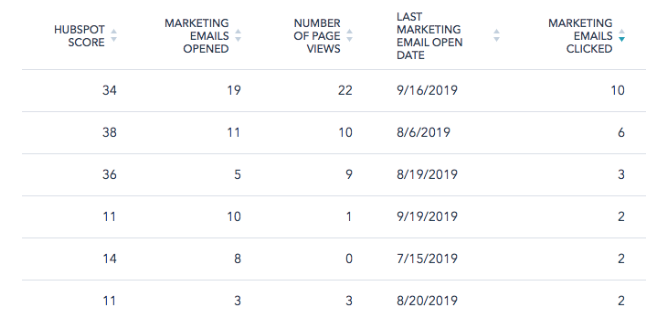
In the fourth blog of my HubSpot lead scoring series, I will be discussing what you should know about monitoring lead scoring. My first two blogs covered positive scoring and negative scoring attributes, and the third one discussed what you needed to know about scoring email drips. If you haven’t already, I recommend reading these before or after reading this one to help you gain a better understanding of what all goes into lead scoring email drips, and how you should be using them.
Why You Should Be Monitoring Lead Scoring
Monitoring lead scoring allows the sales team to distinguish the difference between a qualified prospect to allow the proper group to be targeted with marketing materials.
Once you have your initial lead scoring framework implemented, it’s important to make sure it’s functioning as intended. Similar to anything you’ll do in digital marketing, continuous improvement is part of the process.
After you’ve run lead scoring for a month or so, ask yourself some of these questions:
If prospects have met the target score, are they truly qualified?
- What kind of conversations have they had with sales? Did they mention a particular email or resource that encouraged them to connect?
Are prospects meeting the target score too quickly?
- If prospects seem to be reaching the target score but aren’t ready for sales conversations, this could be an indication that the target score is too low, the existing action values are too high, or prospects need more information to understand your product/their need (dependant on industry and offering).
Is the target score too high or inhibitive?
- If you’re seeing engagement with your website and emails but little to no prospects reaching the target score, it may be worth lowering the target score, increasing the value of positive attributes, or both.
- As prospects meet the target score, evaluate their quality to determine if they’re ready to talk to sales
- If they are ready to talk, keep the lower target score. If they aren’t ready, they may just need more chances to familiarize themselves with your business, so think about the extra resources you can send their way to boost them to the target score.
How are prospects engaging with the lead scoring drip campaigns?
- Are you seeing meetings booked through or direct replies to the drip emails?
- Are open/click rates what you would expect? How do they compare to the results from your typical prospect email?
- You can take any insight here and identify opportunities to refine your messaging and linked resources
Have you uncovered any additional positive and/or negative attributes?
- This opportunity to catch more leads may help better define your company’s definition of a qualified lead
- As a result, there could be positive or negative attributes that you didn’t consider initially, you didn’t realize were important until now, or simply didn’t exist at the time
Creating Custom Lists and Dashboard Reports to Track Top Engaged Contacts
Overall Lead Scoring Progress
Every contact in your HubSpot database will have a lead score value. It’s easy to see which contacts are in your lead scoring drip campaigns, as you can see the list of contacts currently enrolled in the workflow within HubSpot.
However, it can be difficult to keep track of everyone else, especially the most engaged prospects. This is where custom lists and dashboard reports come into play.

These are examples of lead scoring lists.
You can create lists that group prospects according to what makes sense to you. For example, you could create a list that shows everyone who has a lead score greater than 0. From there, you could scale up, creating prospect lists between 1 and 5 points, 6 and 10 points, 11 and 15 points, and so on.
These lists will give you quick numbers on the progress of your lead scoring and give you easy access to the engaged prospects. To complement the lists, you can also create custom dashboard reports that offer insight into lead scoring.
A report that our company has seen much success with is a top engaged contact report based on lead score.

Example of a top engaged contact dashboard report
We set a base lead score (in this case it was 10 points) and pull a list of every contact above that score within the last 30 days. This report includes their total score, number of marketing emails opened, number of page views, date of last marketing email open, and marketing emails clicked.
This report shows your sales team the prospects that they should be most focused on and gives you insight into what actions seem to be driving the most points. The reports are also a great showcase of the effectiveness of your marketing efforts in addition to the standard email and traffic reports.
With your lead scoring framework implemented, you’ll likely want to track your progress. Although you can set up internal notifications when prospects meet the target score, you can also use custom lists and custom dashboard reports to determine prospects that have met the target score, prospects that are close to meeting the target score, prospects that are currently in the lead scoring drips, and prospects that went from the lead scoring drips into your pipeline over time.
Being able to show that X% of the database has opened an email or visited the website at least once can be huge for some marketers. It’s important to keep track of the outcomes of your hard work so you can make improvements, which I will cover in my final blog.
TALK WITH US TO GET STARTED
As you begin your own journey to set up a CRM and qualifying leads, you may find that you would like to speak with an expert to get you started.
Whether you’re just getting started with HubSpot or are looking to get the most out of your current setup, we would be happy to help. Contact us today so we can get started!
